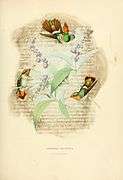Frilled coquette
| Frilled coquette | |
|---|---|
.jpg) | |
| A frilled coquette male at Itatiaia National Park, Rio de Janeiro state, Brazil | |
.jpg) | |
| Lophornis magnificus caught in flight | |
| Scientific classification | |
| Kingdom: | Animalia |
| Phylum: | Chordata |
| Class: | Aves |
| Order: | Apodiformes |
| Family: | Trochilidae |
| Genus: | Lophornis |
| Species: | L. magnificus |
| Binomial name | |
| Lophornis magnificus Vieillot, 1817 | |
The frilled coquette (Lophornis magnificus) is a species of hummingbird in the family Trochilidae.[2]
Etymology
The genus name derives from the Greek words "lophos λοφος"meaning "crest, tuft, forelock" and "ornis ορνις", " meaning bird. The species name "magnificus" is the Latin word for "magnificent, splendid".
Description
Lophornis magnificus is one of the smallest birds alive. This hummingbird can reach a length of 6.5 to 7 cm (2.6 to 2.8 in) and a weight of 2.1 g (0.074 oz).[3][4]
The males of this striking bird have a long, rufous-orange erectile crest and green and white fan-shaped cheek feathers. The forehead and throat are iridescent green, which in certain lights look black. The female is duller in color than the male and lacks the crest and the fanning cheek feathers. Both sexes have a coppery green back with a whitish rump band. The tail is golden rufous. The underparts are whitish-greenish. The inner half of the bills is red, while the tip is black. These short, thin, straight bills has a long tongue used to eat nectar.[5]
Biology
These hummingbirds feed on small arthropods and on the nectar of small flowers (mainly Cirus, Delphinium and Duranta arborensis.[6]
In the mating season (August–March) the males follow the females until they slow their flight. After that both birds are facing and flapping their wings up and down. The cup-shaped nest, which is located close to the ground, is made of parts of plants, moss and bark, camouflaged with green and whitish lichens and silk threads of spiders.[6]
Distribution
This species has an extremely large range, but can be found only in Brazil.
Habitat
Its natural habitats are subtropical or tropical moist lowland Atlantic forests, coffee plantations and heavily degraded former forest, at an elevation up to 1,000 metres (3,300 ft) above sea level.
Gallery
 A perched male of Lophornis magnificus
A perched male of Lophornis magnificus Illustration from Histoire naturelle des oiseaux-mouches (1861)
Illustration from Histoire naturelle des oiseaux-mouches (1861)- Museum specimen of Lophornis magnificus
 Distribution map of Lophornis magnificus
Distribution map of Lophornis magnificus
Bibliography
- Rolf Karl Heinz Grantsau: Die Kolibris Brasiliens. Expressão e Cultura, Rio de Janeiro 1988, ISBN 978-8-5208-0101-7.
- Das große Weltreich der Tiere. Übersetzung aus dem Englischen, S. 278, 279, Hrsg. Philip Withfield, Verlag: Planet Medien AG, Zug 1992, ISBN 3-8247-8614-1
- James A. Jobling: Helm Dictionary of Scientific Bird Names. Christopher Helm, London 2010, ISBN 978-1-4081-2501-4.
- Louis Jean Pierre Vieillot: Nouveau dictionnaire d'histoire naturelle, appliquée aux arts, à l'agriculture, à l'économie rurale et domestique, à la médecine, etc. Par une société de naturalistes et d'agriculteurs. Bd. 7, Deterville, Paris 1817 (Online Biodiversity Heritage Libraries).
- Clements, J. F., T. S. Schulenberg, M. J. Iliff, B.L. Sullivan, C. L. Wood, and D. Roberson. 2011. The Clements Checklist of Birds of the World Cornell University Press.
References
- ↑ BirdLife International (2012). "Lophornis magnificus". IUCN Red List of Threatened Species. Version 2013.2. International Union for Conservation of Nature. Retrieved 26 November 2013.
- ↑ ITIS Report
- ↑ Wood, The Guinness Book of Animal Facts and Feats. Sterling Pub Co Inc. (1983), ISBN 978-0-85112-235-9
- ↑ CRC Handbook of Avian Body Masses by John B. Dunning Jr. (Editor). CRC Press (1992), ISBN 978-0-8493-4258-5.
- ↑ Neotropical Birds
- 1 2 Handbook of the birds of the world
External links
| Wikispecies has information related to: Frilled coquette |
| Wikimedia Commons has media related to Frilled coquette. |
- Frilled coquette videos on the Internet Bird Collection
- Image at ADW
